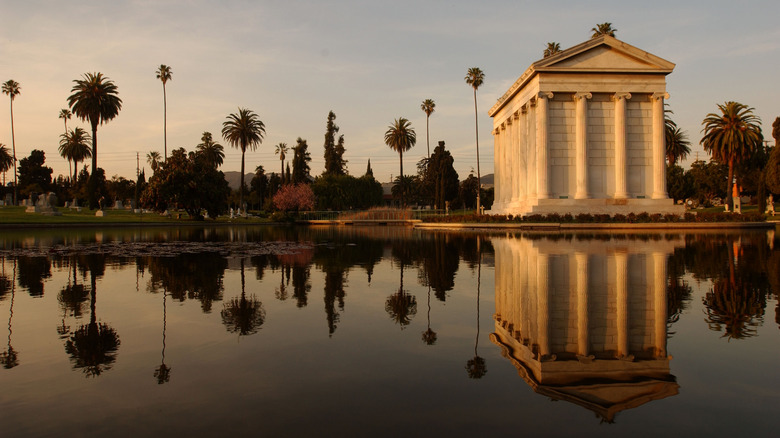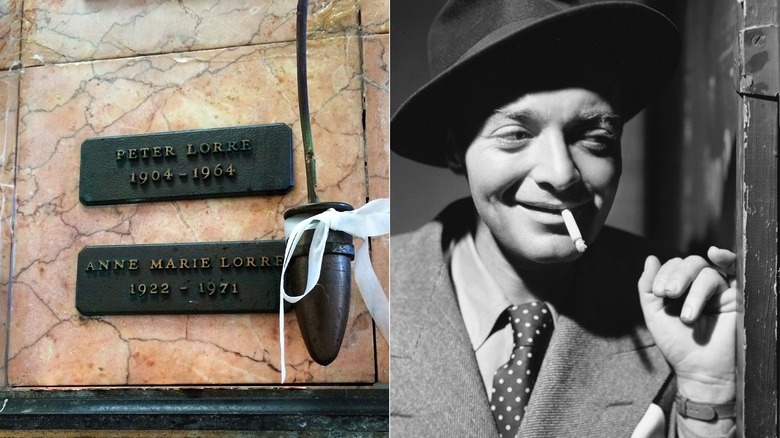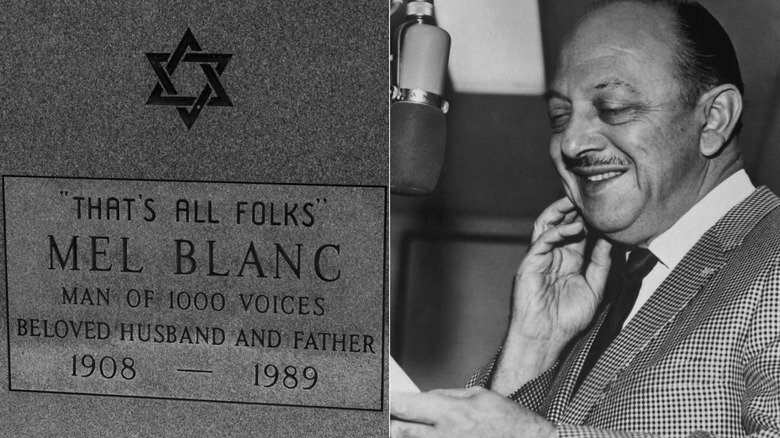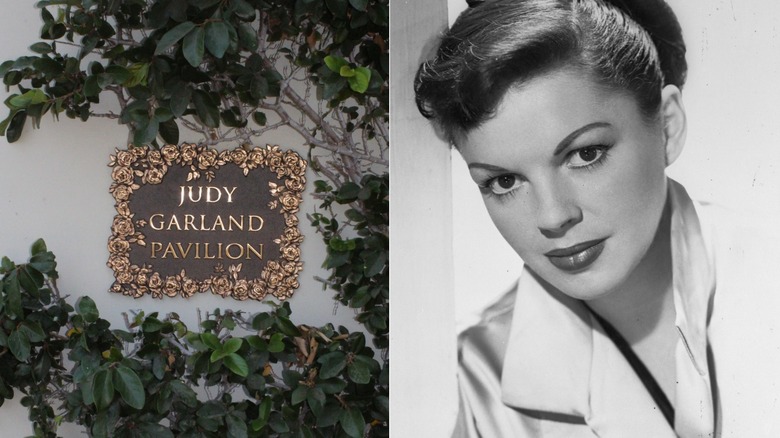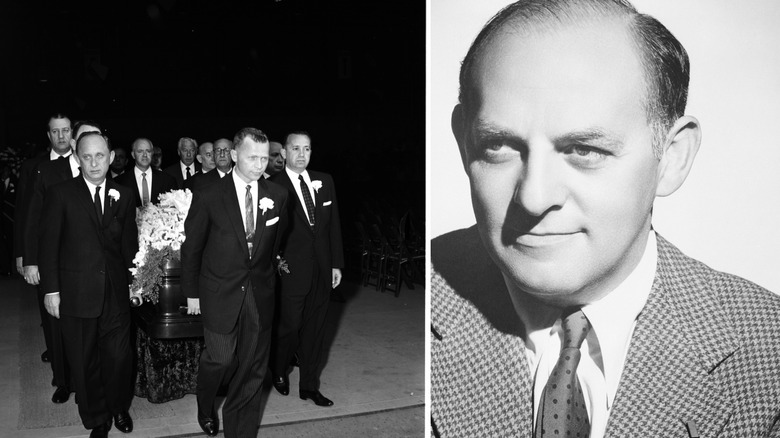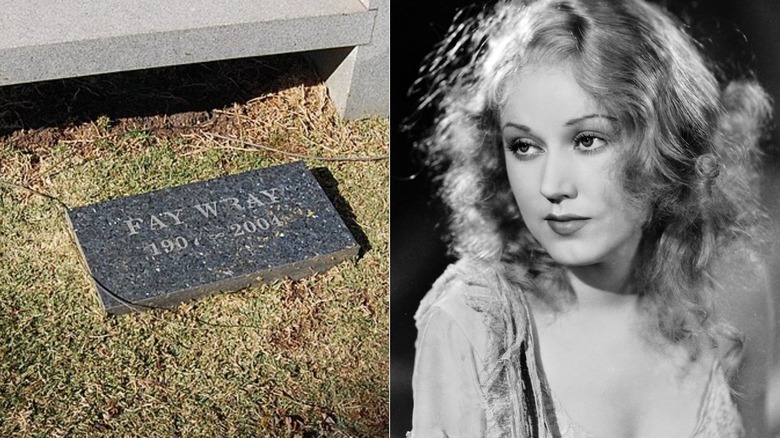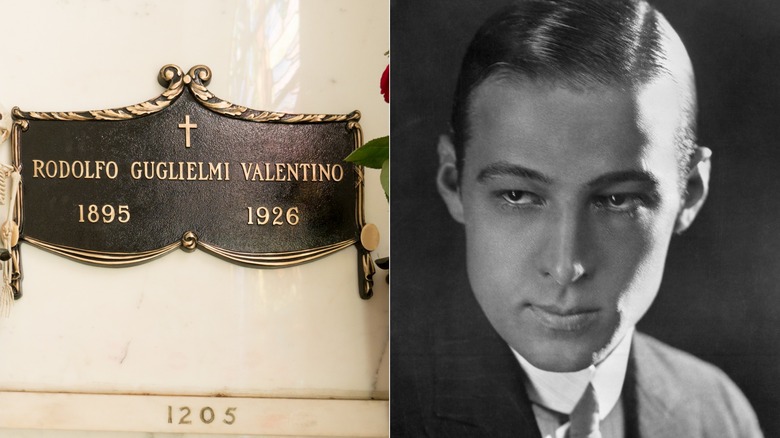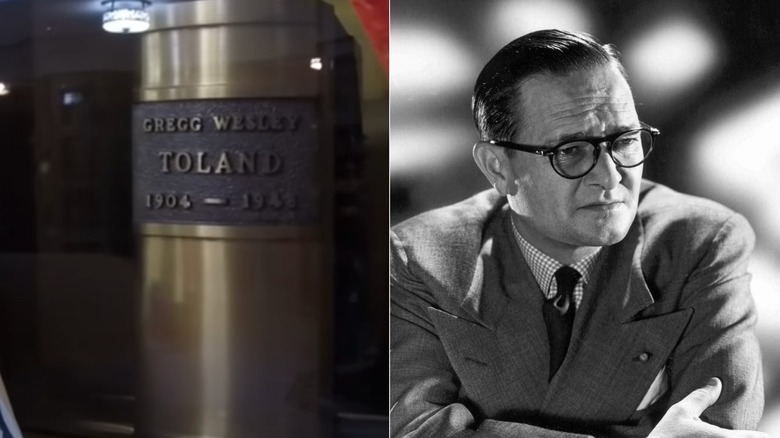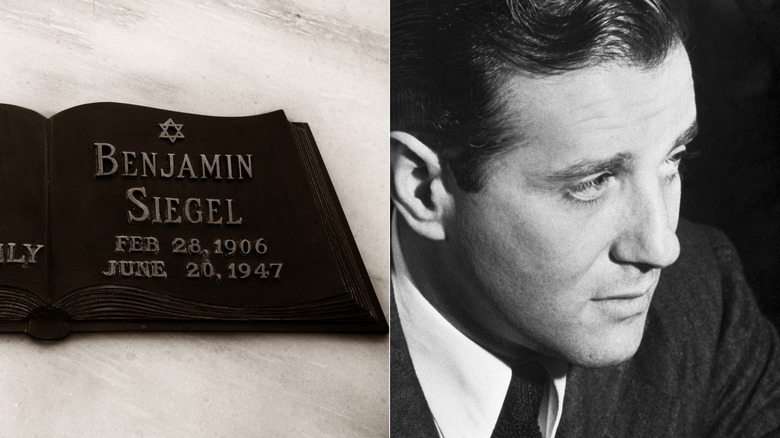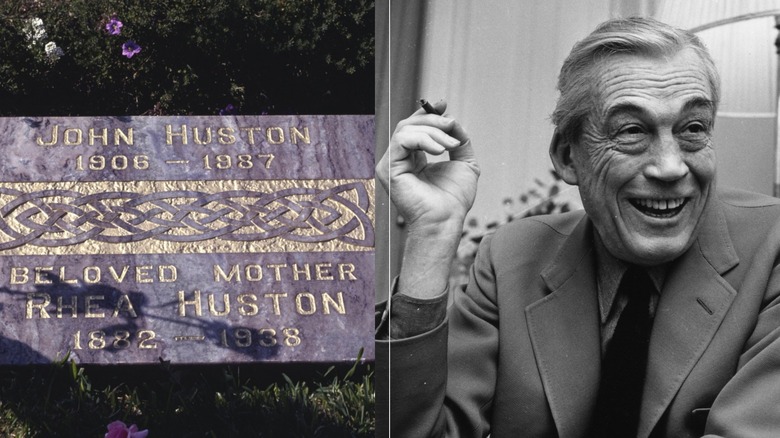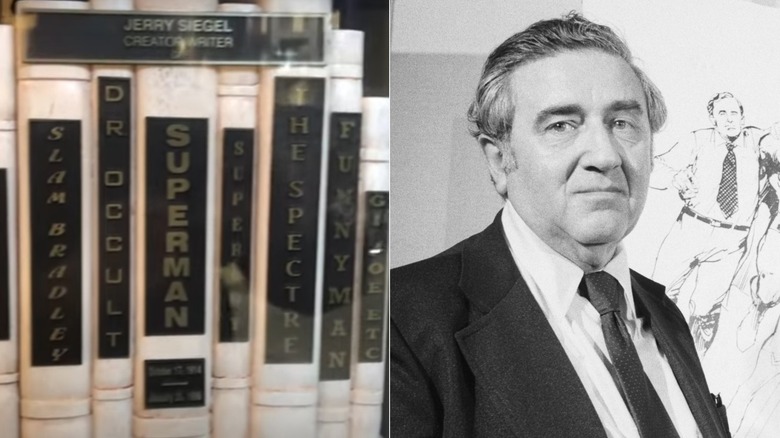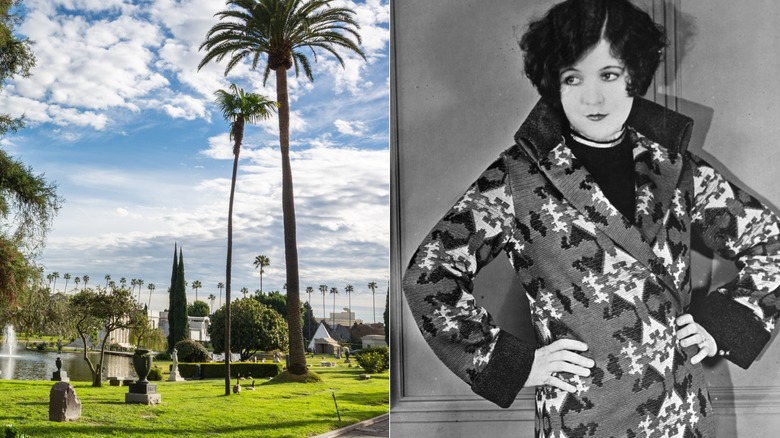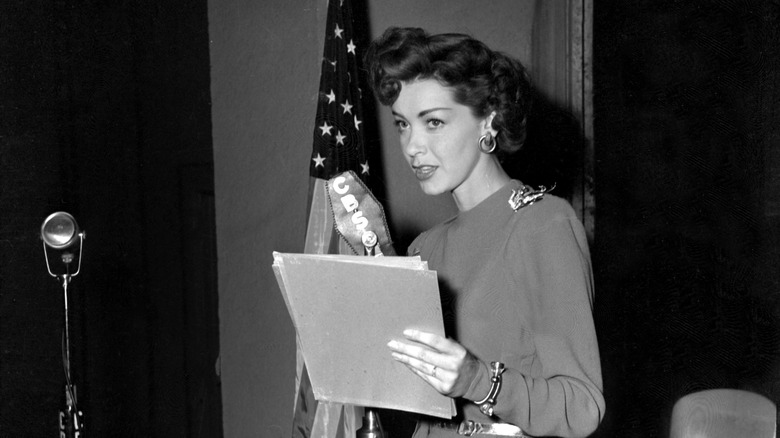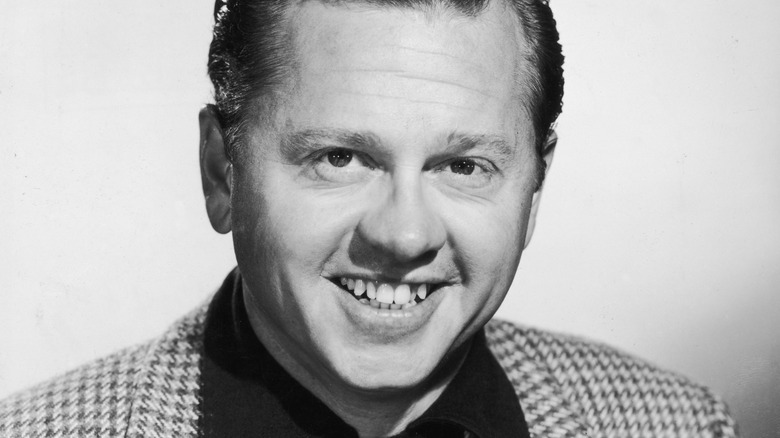14 Famous Graves You Can Visit At LA's Hollywood Forever Cemetery
The Hollywood Forever Cemetery is one of the oldest on the West Coast and contains the graves of some of the biggest stars and most famous filmmakers from Hollywood's silent era, Golden Age, and beyond.
The list of stars at Hollywood Forever is staggering. Just as notable are the ones who are missing. Academy Award-winning actress Hattie McDaniel specifically requested to be buried there, but when she died in 1952, cemeteries in the area never allowed Black people to be buried alongside white ones. Today, a cenotaph to McDaniel can be found in the Garden of Legends, South of the Lake, which has a view of the Hollywood sign – but her body is elsewhere.
For fans of film history, The Hollywood Forever Cemetery is one of the most fascinating destinations in Hollywood, and many travel there every year to pay tribute to some of the most influential figures in Hollywood history.
Peter Lorre
On March 23, 1964, Peter Lorre was supposed to go to a divorce hearing to work out the details of ending his marriage to his estranged wife, but he never arrived. He was still in his pajamas, lying on the floor beside the bed in his apartment on Hollywood Blvd. After years of high blood pressure, he had suffered a stroke.
As reported by the New York Times, his funeral, which included rites from a rabbi, was attended by around 500 people, many of whom were colleagues from his decades of work in film. Along with famous classics like Hitchcock's "The Man Who Knew Too Much," "Casablanca," and "The Maltese Falcon," Peter Lorre was famous for playing villains, like the terrifying child killer in "M" and the comedic plastic surgeon in "Arsenic and Old Lace." At his funeral, fellow horror veteran Vincent Price gave the eulogy. Prior to the service, Price told the LA Times that he was crushed at the loss of his friend and frequent co-star, saying, "Peter [Lorre] liked to make pictures which entertained people, not critics. He didn't have any pretensions about conveying messages to the world."
Fans wishing to pay tribute to Lorre can find his cremated remains at the Cathedral Mausoleum, Corridor C, Alcove of Reverence, niche 5, tier 1.
[Image by Arthur Dark via Wikimedia Commons | Cropped and scaled | CC BY-SA 4.0]
Mel Blanc
When beloved voice actor Mel Blanc turned 80, Warner Bros. honored the man behind Bugs Bunny, Daffy Duck, and literally thousands more cartoon characters with a massive party on their Burbank Lot. As Blanc recounted in his memoir, people continued to ask him when he was going to retire. He replied, "The day I drop." At the age of 81, after chest pains, Blanc was admitted to the hospital. He died of heart disease and emphysema on July 10, 1989. He had been true to his word and had been recording in his home studio the day before he was admitted to the hospital, along with his son Noel Blanc who Mel stated was able to do his voices so well that his characters would be able to live on through him.
As described in "Mel Blanc: The Man of a Thousand Voices" the funeral was attended by hundreds of fans, friends, and colleagues before he was buried privately at Hollywood Forever's Jewish cemetery. His son Noel stated, "I guess everybody in the world loved him. What more is there than that?"
Fans of Mel Blanc and the hundreds of characters whose voices he created can find his grave in section 13, Pinewood, Plot #149. His headstone features his character Porky Pig's famous catchphrase: "That's all, folks!"
Judy Garland
"Judy [Garland]'s great gift was that she could wring tears out of hearts of rock," actor James Mason stated in his eulogy. She had certainly touched the hearts of fans in films like "A Star is Born," "The Wizard of Oz," and "Meet Me in St. Louis" and after her death, thousands turned out to show their love for her.
In 1969 Judy Garland was found dead in her apartment from an accidental drug overdose. She was 47 years old. Her body was flown from London to New York City to a funeral home on Madison Avenue, where her glass-covered casket was on view before the funeral. As reported by The Desert Sun, the funeral home pledged to allow as many fans to come through as wanted to pay their respects, regardless of their usual hours. It is believed that around 20,000 people came to pay tribute to the star. The funeral itself was private, with around 350 guests, though outside the street was crowded with fans. Many of her colleagues including Lauren Bacall, Ray Bolger, and Mickey Rooney attended the ceremony.
Originally, Garland was laid to rest in Ferncliff Cemetery in Hartsdale, New York, but in 2017 she was moved to Hollywood Forever Cemetery, in accordance with her children's wishes. Today, her remains can be found in a section of the Abbey of the Psalms Mausoleum in the Garden of Israel renamed the Judy Garland Pavilion, wall section 29, crypt B-35.
Harry Cohn
On Sunday, March 2nd, 1958 around 1300 film industry professionals gathered on Columbia Pictures Stage 12 – but they weren't there to make a movie. Instead of a film set, there was a single raised platform. On it was a casket. This was the funeral of Harry Cohn, the man who ruled Columbia like his own private dictatorship for almost four decades. As described in a 1958 report from Variety, during the eulogy, actor and comedian Danny Kaye gestured to the studio around them saying, "This was Cohn's cathedral."
"King Cohn" transformed Columbia into a star-powered movie-making machine, but although he shaped Hollywood's Golden Age, his legacy is one of control, intimidation, and sexual exploitation. He was known for bugging his studios to spy on his employees and expecting aspiring actresses and established stars alike to accept sexual harassment and assault if they wanted to work in Hollywood.
Cohn was buried privately after the Hollywood service. His remains can be found by the Cathedral Mausoleum in section 8, Garden of Legends, lot 86, grave 1.
If you or anyone you know has been a victim of sexual assault, help is available. Visit the Rape, Abuse & Incest National Network website or contact RAINN's National Helpline at 1-800-656-HOPE (4673).
Fay Wray
Scream Queen Fay Wray made around 100 films in her long career, including "One Sunday Afternoon" and "The Mystery of the Wax Museum," but she will always be remembered for her role in one film: "King Kong." During the film, she is captured by the enormous, titular ape and carried up the Empire State in his closed fist, while she gives her now-famous scream. After her death in 2004, the lights on the Empire State Building were dimmed for 15 minutes in her honor.
In 1998, the fiercely independent actress had suffered a terrible fall in her home in New York. As film historian Kevin Brownlow told the Independent, although she had been seriously injured and was unable to move until she was discovered three days later, she managed to persuade her loved ones that she could still live alone and attend film industry events. She was right. The actress lived for another six years. Her death was announced by documentarian Rick McKay, who stated in a report from CBS News, "She just kind of drifted off quietly as if she was going to sleep."
Although there was no public service for Wray's fans at the time of her death, her fans can visit her grave in the Garden of Legends (section 8), lot 2300, grave 7.
[Image by Meribona via Wikimedia Commons | Cropped and scaled | CC BY-SA 3.0]
Rudolph Valentino
In August of 1926, New York City streets were flooded with more than 100,000 people. While many were lined up patiently, some were rioting, smashing windows, and fighting with police who struggled to keep the rowdy crowd in line. They were there to see the body of 31-year-old silent film star Rudolph Valentino.
When early Hollywood sex symbol Valentino died of an infection from a ruptured ulcer there was chaos. The funeral was attended by the biggest stars of the era, including Douglas Fairbanks and Mary Pickford. Valentino's girlfriend Pola Negri very publicly collapsed in front of the press several times on the way to the New York funeral. After the service, Valentino's body was sent across the country to California where another funeral was performed and his body was placed into a crypt.
Even his burial couldn't stop the mourning. Every year on the anniversary of his death, a woman in a long black veil arrived to lay a rose on his grave. Over the years, she was joined by more women, dressed the same way, until there were about a dozen Ladies in Black. To visit the crypt with flowers of their own, fans can go to the Cathedral Mausoleum, Corridor A, A-1, East Wall, Crypt #1205.
Gregg Toland
On September 29th, 1948 it was reported by The Decatur Daily Review that a funeral would be held the following day for a man they dubbed "one of Hollywood's top lensmen": Gregg Toland. As the attendees of the afternoon service of the service at Hollywood cemetery chapel surely knew, this was an understatement.
Toland was the cinematographer responsible for the look of many of the most famous films of Hollywood's Golden Age like "Song of the South," "Grapes of Wrath," and "Intermezzo." He was famous for embracing new technology and using it to push the boundaries of what could be done in film, as he did on "Citizen Kane," with the deep focus shots that have become synonymous with the Orson Welles masterpiece.
At the age of 46, Toland suffered a sudden, fatal heart attack. Two days later, his remains were interred at Hollywood Forever cemetery. Those wishing to visit the great cinematographer can pay their respects at chapel colonnade, lower floor, column H, Tier 4, niche 2.
Bugsy Siegel
On June 20th, 1947, bullets smashed through a Beverly Hills window, instantly killing the 41-year-old man sitting on the couch reading the newspaper. He was Ben "Bugsy” Siegel, a poor Jewish kid from Brooklyn who had become one of the most powerful gangsters in the United States. Along with opening a massive casino and reportedly burying the bodies of his enemies in the garden, attempting to sell weapons to Mussolini, and evading the FBI, Seigel had been cultivating friendships with the biggest stars in Hollywood. After his death, he would be buried in Hollywood's most famous cemetery.
As described in Dean Jennings' "We Only Kill Each Other," LAPD detectives closely watched Seigel's funeral, comparing the guests to mugshots in their pockets, looking for members of Seigel's gang, his assassin, or both. Inside, however, the only people with Siegel's extravagant, hermetically sealed silver and bronze coffin, were a rabbi and five mourners. They were family, not colleagues. By their request, there were no eulogies.
Those wishing to see the final resting place of one of America's most notorious gangsters can find Bugsy Siegel's remains in the Beth Olam Mausoleum, Hall of Solomon, 2nd hallway on the right (M2), South Wall, C-3087.
John Huston
At the age of 81, director, screenwriter, and actor John Huston was still making movies. He was in the process of making a film called "Mister North" based on a Thornton Wilder novel. The filming was taking place in Rhode Island and Huston had rented a home nearby for the duration of the shoot. It was there, on August 28, 1987 that the legendary filmmaker died, due to emphysema. Huston was a lifelong smoker and had recently been hospitalized for pneumonia. As quoted by UPI, his daughter, Anjelica Huston stated that on his deathbed Huston had jokingly asked his longtime companion Maricela Hernandez how much ammunition they had left. When she told him they had plenty, he responded, "Then give 'em hell, honey."
His funeral was private, but a memorial service was held at the Directors Guild of America Theater for his many friends and colleagues, including Lauren Bacall, Harry Dean Stanton, and his "Chinatown" co-star, Jack Nicholson.
Fans of Huston and his many classic films like "The Maltese Falcon" and "Treasure of the Sierra Madre" can find his grave at the Garden of Legends, lot 8, grave 21, on the west side of the lake.
Jerry Siegel
Superman may be the most famous character in comic book history, but the iconic character's creators, Jerry Siegel and Joe Shuster are not as well known. In fact, there was a time when DC Comics fired both men who created Superman and continued to publish Superman comics without credit. By the time Siegel died in 1996, however, it was DC itself that announced his death. As quoted by the LA Times, DC Comic chairman Gerald M. Levin eulogized Seigel and Shuster saying, "Jerry and Joe invented a character who today survives and flourishes in every entertainment medium ... Superman brought hope to millions during the Depression and World War II. He lives on."
Although there was no public service for fans to attend at the time of his death, those wishing to pay tribute to the man behind the Man of Steel can ask Hollywood Forever security staff to unlock Columbarium, go to the upper level, and look in the middle of the East Wall. His remains are contained in a box that resembles a stack of books that Siegel created, including Superman and The Spectre. Beside Siegel are the remains of his wife Joanne, the inspiration for Lois Lane.
Marie Prevost
In January of 1937, silent-era film star Marie Prevost was found dead in her Hollywood apartment. The lurid details of her death blended with rumors, and newspapers published detailed descriptions of what was found in her apartment, how her body was found, and how long they believed that it had been since she died.
As stated in Charles Foster's "Stardust and Shadows," the service was paid for by Prevost's friend and collaborator Joan Crawford. Many Hollywood stars, including Barbara Stanwyck, Douglas Fairbanks, Jr., and Clark Gable attended the funeral, but no members of the press were admitted. Prevost's mother's remains were exhumed, and both mother and daughter were cremated together. The Christian Science funeral was held at the Hollywood Forever Cemetery, and according to Michael Ankerich's "Dangerous Curves Atop Hollywood Heels," the combined ashes were buried under a simple bronze plaque with Marie Prevost's name, although there is debate about the location of the grave.
Mabel Fairbanks
Mabel Fairbanks was among the most skilled figure skaters of her era and one of the top coaches in the United States, helping champions like Tai Babilonia and Randy Gardner, Scott Hamilton, Atoy Wilson, and Kristi Yamaguchi to perfect their performances on the ice. She would certainly have been an asset to the US Olympic team herself, but in the 1930s, she was not allowed to compete because she was Black and Seminole. At that time, the Hollywood Forever cemetery would also have banned her, but by the time she died, the discriminatory policy was no longer in place.
In the 1940s Fairbanks moved to Los Angeles and befriended stars like Cary Grant, Frank Sinatra, and Zsa Zsa Gabor. She spent her last years in Burbank, coaching into her 80s. When she died in 2001, she was buried in Hollywood Forever Cemetery. As quoted by The Guardian, Atoy Wilson eulogized his former coach, saying, "I and everyone else who was ever coached by her knew that she was coaching her students not only to become great skaters but, more than anything, to become great human beings...She coached them to stand on all those podiums even though she never got to stand on one herself."
Her remains are in the Garden of Legends, lot 216, grave 19, on the west side of the lake. The plaque marking her grave features an etching of figure skates and a phrase she used to sign autographs to her fans: "Skatingly Yours."
Marsha Hunt
Marsha Hunt was a successful young character actress with a promising career until paranoia about communist influences in Hollywood drove her out of the industry. When the set decorators of Warner Bros. went on strike, Hunt suggested that rather than trying to root out potential communists the studio should try to address their employees' concerns. For the powers in Hollywood, that was close enough to communist to cut her acting career short – so she became an activist instead.
Hunt died at the impressive age of 104 in the home she had bought in Sherman Oaks when she was in her 20s and working in Hollywood. Her nephew Allan Hunt and friend Elizabeth Lauritsen were with her. According to an article from the Los Angeles Daily News, she was considered the honorary mayor of Sherman Oaks and worked to find housing for homeless mothers and their children. While there was no public service for her admirers to celebrate her life, those wishing to visit her grave can find her at the Abbey of the Psalms, Sanctuary of Trust.
Mickey Rooney
When actor Mickey Rooney died at the impressive age of 93, funeral arrangements had to be put on hold due to a disagreement about where the star should be buried. Originally, Rooney had planned to be buried in Westlake Village cemetery in a plot beside his wife, but the two separated, and the rest of Rooney's family believed that he would no longer want to be buried with her. As described by the LA Times, things took a turn when Rooney's estranged wife and her son (whom Rooney had once accused of abusing him) attempted to have Rooney's body moved without the permission of the rest of his family.
The situation had the potential to become an ugly legal battle, but the night before the scheduled court hearing, an agreement was reached: Rooney would be buried at Hollywood Forever Cemetery. The funeral was small, private, and open only to family. His estranged wife and her son did not attend.
Rooney's remains can be found outside of the Holly Cathedral Mausoleum Extension, W-Wing – N Elev, Elevation 15, Couch Crypt B-1501, in accordance with his family's wishes. The inscription reads: "One of the greatest entertainers the world has ever known. Hollywood will always be his home."
